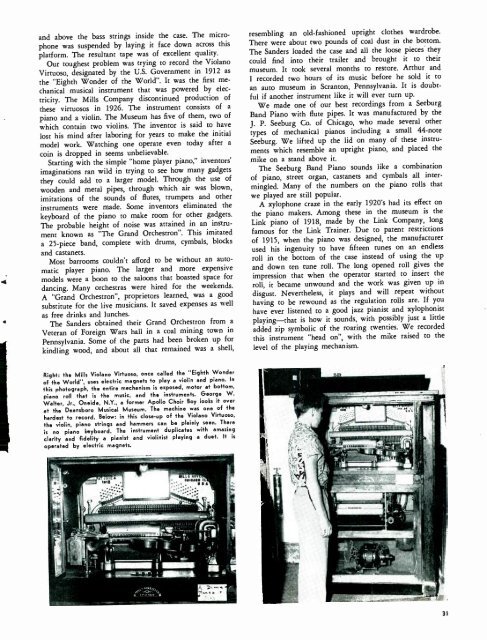Tape Recording Magazine - AmericanRadioHistory.Com
Tape Recording Magazine - AmericanRadioHistory.Com
Tape Recording Magazine - AmericanRadioHistory.Com
Create successful ePaper yourself
Turn your PDF publications into a flip-book with our unique Google optimized e-Paper software.
and above the bass strings inside the case. The microphone<br />
was suspended by laying it face down across this<br />
platform. The resultant tape was of excellent quality.<br />
Our toughest problem was trying to record the Violano<br />
Virtuoso, designated by the U.S. Government in 1912 as<br />
the "Eighth Wonder of the World ". It was the first mechanical<br />
musical instrument that was powered by electricity.<br />
The Mills <strong>Com</strong>pany discontinued production of<br />
these virtuosos in 1926. The instrument consists of a<br />
piano and a violin. The Museum has five of them, two of<br />
which contain two violins. The inventor is said to have<br />
lost his mind after laboring for years to make the initial<br />
model work. Watching one operate even today after a<br />
coin is dropped in seems unbelievable.<br />
Starting with the simple "home player piano," inventors'<br />
imaginations ran wild in trying to see how many gadgets<br />
they could add to a larger model. Through the use of<br />
wooden and metal pipes, through which air was blown,<br />
imitations of the sounds of flutes, trumpets and other<br />
instruments were made. Some inventors eliminated the<br />
keyboard of the piano to make room for other gadgets.<br />
The probable height of noise was attained in an instrument<br />
known as "The Grand Orchestron". This imitated<br />
a 25 -piece band, complete with drums, cymbals, blocks<br />
and castanets.<br />
Most barrooms couldn't afford to be without an automatic<br />
player piano. The larger and more expensive<br />
models were a boon to the saloons that boasted space for<br />
dancing. Many orchestras were hired for the weekends.<br />
A "Grand Orchestron", proprietors learned, was a good<br />
substitute for the live musicians. It saved expenses as well<br />
as free drinks and lunches.<br />
The Sanders obtained their Grand Orchestron from a<br />
Veteran of Foreign Wars hall in a coal mining town in<br />
Pennsylvania. Some of the parts had been broken up for<br />
kindling wood, and about all that remained was a shell,<br />
resembling an old- fashioned upright clothes wardrobe.<br />
There were about two pounds of coal dust in the bottom.<br />
The Sanders loaded the case and all the loose pieces they<br />
could find into their trailer and brought it to their<br />
museum. It took several months to restore. Arthur and<br />
I recorded two hours of its music before he sold it to<br />
an auto museum in Scranton, Pennsylvania. It is doubtful<br />
if another instrument like it will ever turn up.<br />
We made one of our best recordings from a Seeburg<br />
Band Piano with flute pipes. It was manufactured by the<br />
J. P. Seeburg Co. of Chicago, who made several other<br />
types of mechanical pianos including a small 44 -note<br />
Seeburg. We lifted up the lid on many of these instruments<br />
which resemble an upright piano, and placed the<br />
mike on a stand above it.<br />
The Seeburg Band Piano sounds like a combination<br />
of piano, street organ, castanets and cymbals all intermingled.<br />
Many of the numbers on the piano rolls that<br />
we played are still popular.<br />
A xylophone craze in the early 1920's had its effect on<br />
the piano makers. Among these in the museum is the<br />
Link piano of 1918, made by the Link <strong>Com</strong>pany, long<br />
famous for the Link Trainer. Due to patent restrictions<br />
of 1915, when the piano was designed, the manufacturer<br />
used his ingenuity to have fifteen tunes on an endless<br />
roll in the bottom of the case instead of using the up<br />
and down ten tune roll. The long opened roll gives the<br />
impression that when the operator started to insert the<br />
roll, it became unwound and the work was given up in<br />
disgust. Nevertheless, it plays and will repeat without<br />
having to be rewound as the regulation rolls are. If you<br />
have ever listened to a good jazz pianist and xylophonist<br />
playing -that is how it sounds, with possibly just a little<br />
added zip symbolic of the roaring twenties. We recorded<br />
this instrument "head on ", with the mike raised to the<br />
level of the playing mechanism.<br />
Right: the Mills Violano Virtuoso, once called the "Eighth Wonder<br />
of the World uses electric magnets to play a violin and piano. In<br />
this photograph, the entire mechanism is exposed, motor at bottom,<br />
piano roll that is the music, and the instruments. George W.<br />
Walter, Jr., Oneida, N.Y., a former Apollo Choir Boy looks it over<br />
at the Deansboro Musical Museum. The machine was one of the<br />
hardest to record. Below: in this close -up of the Violano Virtuoso,<br />
the violin, piano strings and hammers can be plainly seen. There<br />
is no piano keyboard. The instrument duplicates with amazing<br />
clarity and fidelity a pianist and violinist playing a duet. It is<br />
operated by electric magnets.<br />
31
















